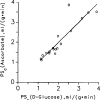A comparison of ascorbate and glucose transport in the heart
- PMID: 3893161
- PMCID: PMC4037164
- DOI: 10.1152/ajpheart.1985.249.1.H141
A comparison of ascorbate and glucose transport in the heart
Abstract
Multiple indicator-dilution experiments were done to compare the transcapillary exchange of tracer amounts of L-[14C]ascorbate and D-[3H]glucose (against an intravascular reference 131I-albumin) in Ringer-perfused (5 mM glucose) isolated rabbit hearts. The indicator-dilution curves for the two were virtually superimposed over the first 40-80 s. Estimates of the capillary permeability-surface area products, PSc, were the same, 2.3 +/- 0.7 (SD) ml X g-1 X min-1 (n = 18), in accord with the coincidence of their instantaneous extractions. The similarity of glucose and ascorbate permeabilities is explained by the similarity in molecular weights and passive diffusivity, their lipophobic nature, and the paucity of carrier-mediated endothelial transport for either molecule. The data were analyzed via a model composed of aggregates of spatially distributed capillary-tissue units (capillary blood, interstitium, myocytes) accounting for the heterogeneity of regional flows. The interstitial volumes in this preparation are enlarged, 0.30 +/- 0.04 ml/g. There is substantial entry into myocardial cells, the cell permeability-surface area products being approximately 2-3 ml X g-1 X min-1 for ascorbate and glucose. The estimated volumes of interstitial and intracellular space, 0.30 and 0.47 ml X g-1 X min-1, reflect interstitial edema and are very close to measured values, giving reassurance concerning the methods of modeling analysis.
Figures



References
-
- Bassingthwaighte JB, Goresky CA. Handbook of Physiology. The Cardiovascular System. Microcirculation. Vol. 4. Am. Physiol. Soc.; Bethesda, MD: 1984. Modeling in the analysis of solute and water exchange in the microvasculature. pp. 549–626. sect. 2. chapt. 13.
-
- Bassingthwaighte JB, Winkler B. Kinetics of blood to cell uptake of radiotracers. In: Columbetti LG, editor. Biological Transport of Radiotracers. CRC Press; Cleveland, OH: 1982. pp. 97–146.
Publication types
MeSH terms
Substances
Grants and funding
LinkOut - more resources
Full Text Sources
Medical
Miscellaneous

